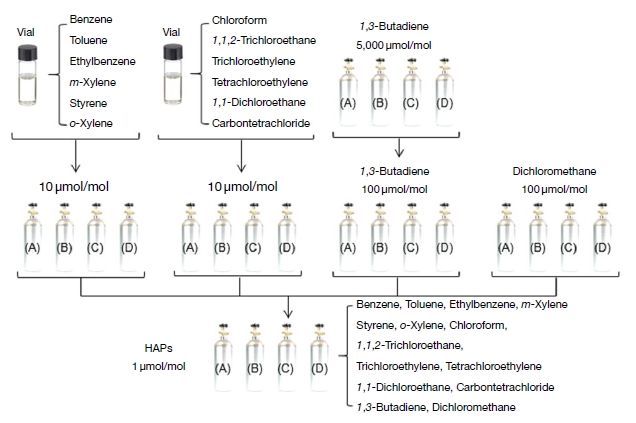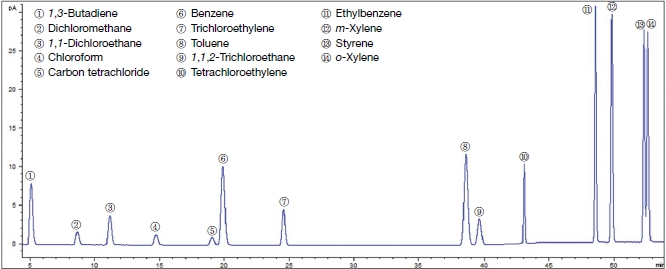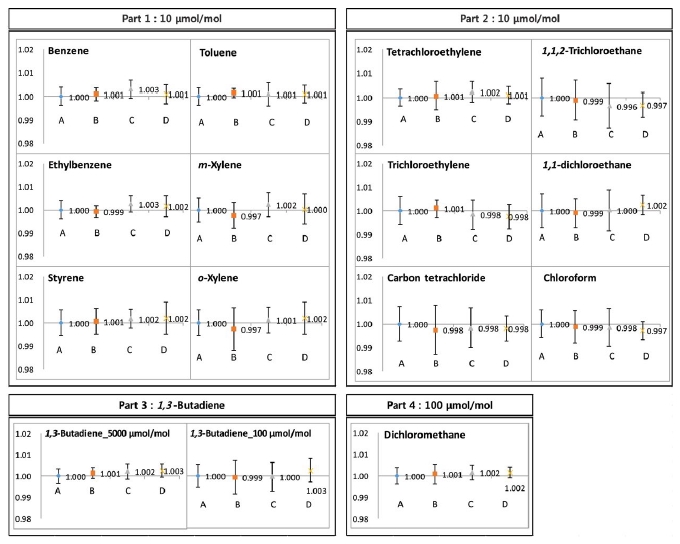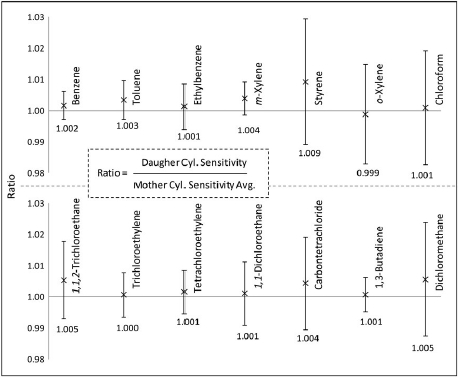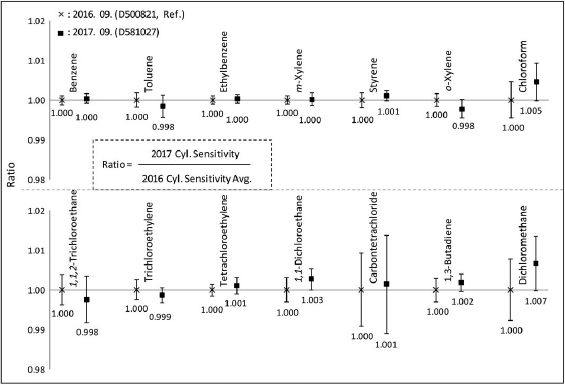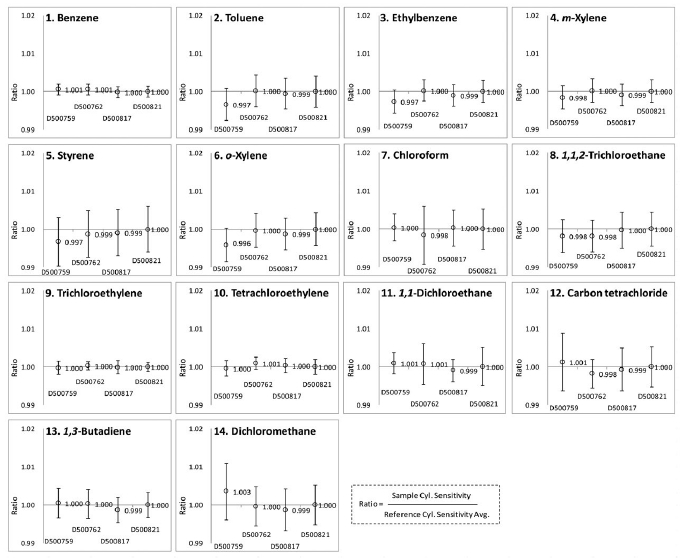
유해대기오염물질 중 14종의 휘발성유기화합물 1차 표준가스개발 (1 μmol/mol 수준)
Copyright © 2018 Korean Society for Atmospheric Environment
Abstract
Hazardous air pollutants (HAPs) in the atmosphere are regulated as major air pollutants in Korea by the Air Pollution Control Act. In order to manage and control HAPs, accurate standards, which are traceable to the International System of Units (SI), are required. In this study, primary standard gas mixtures (PSMs) of volatile organic compounds (VOCs) which are specified as HAPs were developed at 1 μmol/mol levels. The selected fourteen VOCs include Benzene, Toluene, Ethylbenzene, m-Xylene, Styrene, o-Xylene, Chloroform, 1,1,2-Trichloroethane, Trichloroethylene, Tetrachloroethylene, 1,1-Dichloroethane, Carbon tetrachloride, 1,3-Butadiene, and Dichloromethane. The HAPs PSMs were gravimetrically prepared in aluminum cylinders and their consistency was verified within the relative expanded uncertainty of 0.71% (k=2). Potential adsorption loss onto the internal surface of cylinders was estimated by cylinder-to-cylinder division method. No adsorption loss was observed within the uncerainty of 0.53%. The long-term stability of the HAPs PSMs was evaluated comparing with freshly prepared HAPs PSMs. The HAPs PSMs were stable for one year within the uncertainty of 0.38%. The final uncertainty of the PSMs was determined by combining the preparation uncertainty, verification uncertainty, and stability uncertainty. Finally, traceable and stable HAPs PSMs at 1 μmol/mol levels were developed with the uncertainty of less than 0.76% in high-pressure aluminum cylinders.
Keywords:
HAPs, Calibration standard, Primary standard gas mixture, VOCs1. 서 론
2012년 세계보건기구 (WHO, World Health Organization)는 전 세계 사망자 중 약 8분의 1인 700만 명이 대기오염과 관련되어 사망했다는 보고서를 발표했다 (WHO, 2014). 이런 막대한 인명피해를 일으키는 주요 대기오염물질로는 환경정책기본법에서 아황산가스, 일산화탄소, 이산화질소, 오존, 벤젠, 그리고 납 등이다 (Korea MOE, 2017a). 이처럼 환경정책법령에서 규제하고 있는 물질 외에도 다양한 유해화학물질들이 있으며, 이들에 대한 관리 역시 필요하다 (NIER, 2012). 유해대기오염물질 (HAPs, Hazardous Air Pollutants)들은 물질 특성으로 인해 대기 중에서 다양한 독성형태로 변형되며 (Kelly et al., 1994), 대기 중에서 미량만으로도 독성, 발암성, 또는 생체축적 등의 문제를 일으켜 인간 및 동·식물에 악영향을 줄 수 있다 (Suh et al., 2000). 휘발성유기화합물 (VOC; Volatile Organic Com-pounds)은 HAPs의 주요 성분 중 하나로써 (Caldwell et al., 1998), 자동차 및 제조 시설 등의 다양한 배출원에서 배출되고 있다 (Özkaynak et al., 2008). 우리나라에서는 HAPs 중 VOCs 연간 배출량이 약 38만 톤으로 보고되었고 (Hong et al., 2003), 미국에서는 연간 약 1,830만 톤이 배출되는 것으로 보고되었다 (US EPA, 2015). 아울러 우리나라의 대기 중 VOCs의 농도는 약 0.06 nmol/mol에서 19.2 nmol/mol 수준으로 측정되었고 (Kim, 2006), HAPs의 대기 농도는 약 2.45 nmol/mol에서 41.1 nmol/mol 수준으로 측정되었다 (Ahn et al., 2006). 이러한 배경농도를 추정하기 위해 모니터링과 보편화된 방법이 확립되어야 하지만 HAPs 중 VOCs의 측정 방법과 신뢰성은 완전하게 정립되지 않은 상태이다 (Seo et al., 2011).
한편 HAPs를 줄이기 위해 나라별로 법령으로 정의하고 이를 규제하고 있다. 우리나라에서 HAPs의 정의는 대기환경보전법에서 ‘특정대기유해물질’로 사람의 건강, 재산이나 동식물의 생육에 직접 또는 간접적으로 위해를 줄 우려가 있는 대기오염물질로서 환경부령으로 정한 것을 말한다 (Korea MOE, 2017b). 미국의 경우 Clean Air Act - Section 112 (b)에서 암의 유발과 같이 사람의 건강에 심각한 악영향을 끼치거나 생태계 손상을 유발하는 것으로 의심되는 오염물질로 정의하며, 187종의 HAPs를 규제하고 있다 (US EPA, 2011). 또한 경제협력개발기구 (OECD, Organization for Economic Cooperation and Development)에서는 동식물이나 인간의 건강에 위해를 주는 독성 등을 가진 대기 중 미량의 가스상 또는 입자상 오염물질로 정의하고 있다(OECD, 1999). 우리나라 환경부에서는 대기 중으로 직접 배출되는 대기오염물질을 관리하기 위해 대기환경보전법 규정에 따라 유해대기오염물질측정망을 2011년 설치하였고, HAPs 비산배출시설 관리제도를 2015년부터 시행하였다. 유해대기오염물질측정망은 도시지역, 산업단지 및 배경농도 지역에서 HAPs 중 중금속을 제외한 성분을 대상으로 운영된다. HAPs 중 대기 농도 수준, 독성 및 발암성 등의 인체 유해도와 측정 용이성 등을 검토하여 VOCs 중 14종과 PAHs (Polycyclic Aromatic Hydrocarbon) 중 7종이 선정되었다. VOCs 14종은 Benzene, Toluene, Ethylbenzene, m-Xylene, Styrene, o-Xylene, Chloroform, 1,1,1-Tri-chloroethane, Trichloroethylene, Tetrachloroethylene, 1,1-Dichloroethane, Carbon tetrachloride, 1,3-Butadiene, 그리고 Dichloromethane이다. 이러한 VOCs를 실험실에서 측정하기 위해서는 고농도의 혼합표준물질을 nmol/mol 수준으로 테들러 주머니에 희석하여 사용해야 하며 (Korea MOE, 2016), 이 과정은 상대법을 이용하는 분석법의 특성상 분석정확도에 오차를 수반할 수 있기 때문에 대기 중 농도 수준인 수 nmol/mol에서의 유효한 표준가스의 필요성이 요구되고 있다. 이러한 실제 대기 중 농도 수준의 표준가스의 사용은 분석자가 테들러 주머니에 고농도의 혼합표준가스를 희석할 때 발생될 수 있는 불확도 요인을 제거하여 측정의 소급성 확보 및 분석 결과의 신뢰성을 향상시킬 수 있다. 따라서 본 연구에서는 HAPs 중 VOCs 14종에 대한 수 nmol/mol 수준의 표준가스의 개발을 위한 기초연구로써 중량법 (ISO 6142-1, 2015)을 적용하여 1 μmol/mol 수준의 표준가스를 개발하고자 하였다. 이를 위해 원료시약의 불순물 분석, 표준가스의 제조일치성, 실린더의 단기 및 장기 안정성 평가를 통하여 인증표준물질을 개발하였다.
2. 실험 방법
2. 1 시약 및 재료
1,1,1-Trichloroethane은 우리나라에서 판매가 금지된 시약이므로 1,1,2-Trichloroethane (98%) (Tokyo Chemical Industry, Japan)으로 대체하여 표준물질 제조에 사용하였다. 1,1,2-Trichloroethane을 제외한 13종 원료 시약은 순도가 99% (Sigma Aldrich, USA) 이상인 것을 사용하였으며, 바탕가스로는 초고순도질소 99.9999% (덕양가스, Korea)를 사용하였다. 표준가스 제조 시 바탕가스가 정화장치 (SP600-203FV, SAES Pure Gas, USA)를 통과하도록 하여 VOCs 및 H2O 등의 불순물이 100 pmol/mol 이하 수준으로 제거된 상태에서 주입될 수 있도록 하였다.
실린더는 알루미늄 실린더로써 내부부피가 10 L인 실린더 (Luxfer, United Kingdom)와 내부부피가 6 L인 실린더 (Luxfer, Australia)를 사용하였다. 실린더의 질량은 최대용량이 26.1 kg이고 분해능이 1 mg인 전자저울 (XP-26003L, Mettler-Toledo, Switzerland)을 사용하여 측정하였으며, 측정 전에 10 kg의 표준분동 (Mettler-Toledo, E2급)으로 저울을 교정하였다. 원료시약의 질량은 최대용량이 205 g이고 분해능이 0.01 mg인 화학저울 (AT201, Mettler-Toledo, Switzerland)을 사용하여 측정하였다.
2. 2 원료시약의 순도분석
원료시약의 순도분석은 불꽃이온화 검출기가 장착된 기체크로마토그래프 기기 (GC/FID; gas chromatograph/flame ionization detector, 7890B Agilent, USA)와 수분분석기 (831 KF Coulometer, Metrohm, Swiss)를 사용하여 수행하였다. GC/FID는 automatic liquid sampler (G4513A, Agilent, USA)에 의하여 각 원료시약 0.2 μL가 온도 200℃, split ratio 100 : 1로 설정된 주입구로 도입되었다. 주입된 원료시약 내 성분들은 운반기체인 헬륨에 의하여 1 mL/min의 유속으로 승온 조건의 오븐 (40℃ (20 min) → 30℃/min (75℃, 30 min) → 10℃/min (200℃, 5 min))에 설치된 모세관 컬럼 (DB-WAX, 60 m×320 μm×0.5 μm, Agilent, USA)을 통과하면서 분리된 후, 250℃로 가열된 검출기에서 검출되었다. 아래 식 (1)을 이용하여 동일한 조건에서 각 원료시약에 대하여 4회의 반복 분석을 수행하였다.
| (1) |
여기서, N은 혼합물 속에 존재하는 불순물 성분의 수이며, xi는 분석에 의해 검출된 불순물 i의 몰분율이다.
2. 3 혼합표준가스의 제조
표준가스 제조 전, 실린더 내부에 존재할 수 있는 미량 수분 및 기타 오염물질을 제거하기 위하여 실린더를 60℃로 가열하면서 터보 펌프로 약 1.33×10-3 Pa (1×10-5 torr)까지 24시간 동안 진공 배기하였다. 또한 실린더 외부에서 먼지와 같은 이물질을 제거함으로써 질량측정에 영향을 줄 수 있는 요인들을 최소화하였다. 실린더 질량측정 시에는 주위 환경에 따른 변화량을 보정하기 위해 보정 실린더 (tare cylinder)와 함께 질량을 측정하였다. 1 μmol/mol HAPs 혼합표준가스는 그림 1과 같이 성분별 특성에 따라서 네 부분으로 나누어 중량법으로 제조하였다 (Part 1: Benzene, Toluene, Ethylbenzene, m-Xylene, Styrene, o-Xylene / Part 2: Chloroform, 1,1,2-Trichloroethane, Trichloroethylene, Tetrachloroethylene, 1,1-Dichloroethane, Carbon tetrachloride / Part 3: 1,3-Butadiene / Part 4: Dichloromethane).
먼저 주사기를 이용한 미세중량법으로 방향족탄화수소 6종 (Benzene, Toluene, Ethylbenzene, m-Xylene, Styrene, o-Xylene)의 시약을 7 mL 용량의 실험용 유리병에 혼합하였다. 이후 실린더에 약 190 μL의 제조된 혼합물을 실린지를 이용하여 주입하고 고순도 질소를 주입하여 10 μmol/mol 표준가스를 제조하였다. 동일한 방법으로 염화탄화수소 6종 (Chloroform, 1,1,2-Trichloroethane, Trichloroethylene, Tetrachloroethylene, 1,1-Dichloroethane, Carbon tetrachloride)을 약 230 μL으로 10 μmol/mol 표준가스를 제조하였다. 1,3-Butadiene은 상온에서 가스 상태이므로 중량법을 이용한 원료가스 약 8 g을 고순도 질소로 희석하여 5,000 μmol/mol 표준가스를 6 L 실린더에 일차적으로 제조하였다. 이후 약 13 g의 5,000 μmol/mol을 2차 희석하여 100 μmol/mol 표준가스를 제조하였다. 마지막으로 Dichloromethane은 다른 성분에 비해 높은 증기압을 가지고 있으므로 약 290 μL의 Dichloromethane 단일 성분으로 100 μmol/mol 표준가스를 제조하였다. 각 Part별로 실린더 4병의 제조일치성을 확인하기 위하여 제조된 표준가스를 GC/FID (7890B, Agilent, USA)에서 비교 분석하여 제조일치성을 확인하였다. 제조일치성이 확인된 각 고농도 표준가스를 실린더에 주입 후 고순도 질소로 희석하여 1 μmol/mol HAPs 혼합표준가스를 4병의 실린더에 제조하였다.
2. 4 HAPs 1 μmol/mol 표준가스 제조일치성 분석 방법
HAPs 1 μmol/mol 표준가스의 제조일치성을 확인하기 위하여 각 실린더에 제조한 표준가스를 GC/FID (7890B, Agilent, USA)에서 비교 분석하였다. 가스성분이 분석기기에 주입되기 전에 흡착 손실될 가능성을 최소화하기 위하여 표준가스가 통과하는 연결관은 불활성 성분으로 코팅된 관 (Sulfinert® coating, Swagelok, USA)을 사용하였고, 전 구간을 열선으로 감싸서 약 50℃의 온도를 유지하였다. 분석 수행 시 기기 드리프트를 보정하기 위하여 기준 실린더 A (Cylinder No. D500821)를 다른 실린더들 (B (D500817), C (D500 759), D (D500762))의 분석 전과 후에 분석하였다 (분석순서: A-B-A-C-A-D-A). 표준가스는 6-포트 밸브가 연결된 5 mL (Sulfinert® coating) sample loop에 포집된 후, 온도 200℃, split ratio 1:1 조건의 GC/FID 주입구에 주입되었다. 운반가스인 헬륨의 유량은 GC-FID 유량 프로그램을 이용하여 15.5 mL/min (39.5 min) → 1 mL/min, 10.8 mL/min으로 설정하였다. Column은 DB-VRX (60 m×320 μm×1.8 μm, Agilent, USA)와 DB-624 (60 m×320 μm×1.8 μm, Agilent, USA)를 직렬로 연결하여 사용하였다. Column이 설치된 오븐 온도는 40℃ (22 min) → 20℃/min (55℃, 18 min) → 50℃/min (100℃, 13.5 min)으로 설정하였으며, 가스성분이 검출되는 검출기 온도는 250℃로 설정하였다. 일반적인 column 사용 유량은 50 m×320 μm 조건에서 1.35 mL/min으로 권장한다 (Mcnair and Miller, 2009). 하지만, 표준가스 성분 14종을 한 가지 분석조건으로 한번에 분석하는 동시에 분석시간을 60분 이하로 단축하기 위해 일반적인 운반가스 유량보다 큰 15 mL/min으로 분석하였다. 분석결과 크로마토그램은 그림 2와 같다. 표준가스 제조는 ISO (6142-1)에 의해 중량법으로 주입된 가스 질량을 측정하여 표준가스 몰분율 (농도)과 몰분율 불확도를 결정하였다. 제조일치성 평가는 GC 분석을 통해 4병의 실린더 중 1병을 기준 실린더로 하였으며, 나머지 3병과의 ratio 차이 (sample cylinder sensitivity/reference cylinder sensitivity)로 불확도를 평가하여 일치성을 확인하였다.
2. 5 HAPs 1 μmol/mol 혼합표준가스 흡착손실 (단기안정성) 확인 방법
HAPs 1 μmol/mol 혼합표준가스가 실린더 내면에서 흡착에 의한 손실이 있는지 평가하기 위하여 분배실험을 수행하였다 (Lee et al., 2017). 이를 위하여 앞서 제조한 4병의 혼합표준가스 실린더 중 1병의 실린더 (mother cylinder, D500759)와 진공 배기된 새 실린더 (daughter cylinder, D500758)를 “T”자 형의 코팅된 관 (Sulfinert® coating)으로 연결하였다. 이때, 관 내부를 고순도 질소가스로 퍼지 (purge)하고 50℃로 가열하면서 2회에서 3회 반복하여 진공 배기를 수행하였다. 이후 mother cylinder 내 표준가스로 관을 퍼지한 후 “T”자 형 관에 부착된 밸브를 천천히 열어 mother cylin-der 내 표준가스를 daughter cylinder로 분배하였다. 분배가 완료된 두 실린더는 혼합장치를 이용하여 3시간 동안 혼합하였다. 분석 전 실린더 표면이 실험실 온도와 같도록 유지하기 위해 실험실에 하루 동안 방치하여 GC/FID를 이용하여 흡착에 의한 농도변화를 확인하였다. 분석은 A (mother cylinder)-B (daughter cylinder)-A (mother cylinder) 순으로 진행하였다.
2. 6 HAPs 1 μmol/mol 혼합표준가스 장기안정성 확인 방법
2016년 9월 10일과 2017년 9월 7일에 각각 제조한 HAPs 1 μmol/mol 혼합표준가스를 같은 조건에서 비교 분석하여 알루미늄 실린더에서 14종 성분들의 1년 장기안정성을 확인하였다. 분석은 A (2016 cylinder)-B (2017 cylinder)-A (2016 cylinder) 순서로 진행하였다.
2. 7 몰분율 평가 방법
표준가스 내 각 성분의 몰분율 (mol fraction, mol/mol)은 각 성분의 순도와 중량법에 의한 질량측정결과로부터 결정된다. 혼합가스의 몰분율은 표준가스 제조 절차서 (ISO 6142-1, 2015)를 활용하여 식 2와 같이 표현된다.
| (2) |
여기서, xi는 최종혼합물 중 성분 i의 몰분율이며, P는 가스의 총 개수, n은 최종혼합물 중의 성분의 총수 mA는 질량측정에 의해 결정된 가스의 질량, MA는 성분 i의 분자량, xi,A는 가스 A 중의 성분 i의 몰분율이다.
2. 8 불확도 평가 방법
중량법 제조 불확도 평가는 GUM Workbench Pro (version 2.3.6.141, Metrodata GmbH, Germany)프로그램을 사용하여 수행하였다. 또한 측정 불확도 평가는 ISO 6142-1과 JCGM 100:2008 (JCGM 100, 2008)에 따라서 식 (3)과 같이 수행하였다.
| (3) |
여기서, u(xprep.)는 제조 불확도, u(xgrav.)는 중량법 불확도, u(xveri.)는 내부일치성 불확도, u(xstab.)는 안정성 불확도이다.
| (4) |
식 (4)와 같이 중량법 불확도 (u(xgrav.))는 원료시약 및 바탕가스의 순도분석 불확도 (u(xpurity))와 표준가스 제조 시의 질량측정 불확도 (u(xweighing))가 합성되었다. 원료시약의 순도분석은 4회 반복 분석한 결과 중 첫 번째 결과를 제외한 나머지 3회 분석 결과를 직사각형 분포로 불확도를 평가하였다. 바탕가스의 순도분석은 초고순도질소 측정한 결과값들을 직사각형 분포로 불확도를 평가하였다. 질량측정 불확도는 측정한 질량측정 횟수 (n)의 표준편차를 으로 나누어 표준 불확도로 평가하였다.
| (5) |
또한 식 (5)와 같이 내부일치성 불확도 (u(xveri.))는 분석 반복성 불확도 (u(xanal. repeatability))와 분석재현성 불확도 (u(xanal. reproducibility))로부터 합성되었다. 여기서 분석 반복성 불확도는 반복 분석하여 나온 불확도를 합성하였다. 분석재현성 불확도는 각 실린더들 간의 분석 값 차이에 대한 분포를 표준 불확도로 평가하였다.
| (6) |
마지막으로 식 (6)과 같이 안정성 불확도 (u(xstab.))는 단기안정성 불확도 (u(xshort term stability))와 장기안정성 불확도 (u(xlong term stability))를 합성하였다. 단기안정성 불확도는 직사각형 분포로 mother 실린더와 daughter 실린더의 차이를 2를 나누고 으로 나누어 주었다. 장기안정성 불확도는 단기안정성 불확도와 동일하게 직사각형 분포로 기준실린더 (2016년)와 샘플실린더 (2017년)간의 차이가 합성되었다.
3. 실험 결과 및 고찰
3. 1 시약의 순도분석 평가 결과
시약의 순도분석은 GC/FID와 수분분석기를 이용하여 4회 반복 분석한 결과 중 첫 번째 결과를 제외한 나머지 3회 분석의 결과를 이용하여 각 성분의 순도를 평가하였다. 시약의 탄화수소 순도분석 결과는 표 1과 같이 성분별로 98.7에서 99.9 cmol/mol (%mol/mol)로 확인되었다. 여기서 확장불확도는 시약을 3회 분석하여 얻어진 분석 반복성 불확도로 최대 460 μmol/mol로 평가되었다.
3. 2 HAPs 고농도 표준가스의 내부일치성 평가 결과
각 Part별 고농도 방향족탄화수소 6종과 염화탄화수소 6종, 1,3-Butadiene, Dichloromethane의 실린더 4병의 내부일치성 결과는 그림 3과 같다. 그림에서 불확도는 내부일치성 불확도와 중량법 불확도를 합성한 것이며, 모든 실린더가 불확도 범위에서 일치하는 것을 확인하였다.
3. 3 HAPs 1 μmol/mol 혼합표준가스의 내부일치성 평가 결과
4개의 알루미늄실린더에서 제조일치성 불확도는 중량법 불확도와 내부일치성 불확도를 합성하였다. 그 결과 상대확장 불확도는 Benzene 0.08%, Toluene 0.33%, Ethylbenzene 0.26%, m-Xylene 0.17%, Styrene 0.28%, o-Xylene 0.38%, Chloroform 0.19%, 1,1,2-Trichloroethane 0.20%, Trichloroethylene 0.04%, Tetrachloro-ethylene 0.11%, 1,1-Dichloroethane 0.17%, Carbon tetrachloride 0.26%, 1,3-Butadiene 0.17%, 그리고 Dichloromethane 0.42%로 4병 모두 해당 불확도 범위 내에서 일치한 것을 확인하였다.
3. 4 HAPs 1 μmol/mol 혼합표준가스의 실린더 내면 (실린더 내부표면) 흡착손실 (단기안정성) 평가 결과
실린더 내 표준가스의 실린더 내면 흡착손실 평가 결과를 mother 실린더 대비 daughter 실린더의 GC/FID 응답값 (GC/FID 피크 면적)의 비로 그림 4에 나타냈었다. 그림에서 오차막대는 불확도를 표현한 것으로 모든 성분이 불확도 내에서 일치한 것으로 보아 실린더 내부 표면에서의 흡착에 의한 표준가스 성분의 손실은 없음을 확인하였다. 아울러 sensitivity는 평균 피크면적에서 몰분율을 나눈 값이다.
3. 5 HAPs 1 μmol/mol 혼합표준가스의 장기안정성 평가 결과
새롭게 제조한 표준가스와 1년 전에 제조한 표준가스의 GC/FID 감도 차이를 비교하여 알루미늄 실린더에서 HAPs 1 μmol/mol 표준가스의 장기안정성을 평가하였다. 그림 5에 나타낸 것과 같이 14성분 모두 불확도 범위 내에서 일치하였다. 이로부터 알루미늄 실린더에서 모든 성분들이 1년 동안 안정하였음을 확인하였다.
3. 6 HAPs 1 μmol/mol 혼합표준가스의 제조일치성 평가 결과
HAPs 혼합표준가스의 최종 불확도는 GUM Workbench Pro를 사용하여 신뢰수준 95% (k=2)으로 평가하였다. 그림 6에 각 성분별로 4병의 실린더 간 내부일치성을 나타내었으며, 확장불확도를 오차막대로 표시하였다. 제조일치성 결과는 표 2와 같으며, 이로부터 제조된 4병의 실린더에서 모든 성분들이 불확도 범위 내에서 일치하는 것을 확인하였다.
4. 결 론
본 연구에서는 중량법을 이용하여 알루미늄 고압실린더에 4부분으로 나뉘어 고농도 표준가스를 제조하였다. 이후 각 고농도 표준가스들의 중량법 제조일치성을 확인하였으며, 최종적으로 HAPs (14종)를 1 μmol/mol 수준으로 혼합 제조하였다. 혼합표준가스의 몰분율과 불확도는 ISO 6142-1과 JCGM 100 : 2008을 이용하여 성분의 순도 정보와 중량법 정보에 의하여 결정되었다. 알루미늄 실린더 내 혼합표준가스의 안정도는 실린더 내부표면에서의 흡착 손실을 평가한 단기안정도 평가와 1년간 실린더 내에서의 안정도를 평가하는 장기안정도 평가로 수행되었다. 그 결과, 14 성분 모두 불확도 범위 내에서 알루미늄 실린더 내부 표면에서 흡착손실이 없었고 1년 동안 알루미늄 실린더 내에서 안정하였다. HAPs 중 14종 VOCs 1 μmol/mol 표준가스의 불확도 평가를 위해 중량법 불확도, 내부일치성 불확도, 그리고 내부안정성 불확도 등을 평가한 결과, 상대확장 불확도는 최대 0.76% (k=2) 미만이었다.
본 연구에서는 소급성 있는 HAPs 1 μmol/mol 표준가스를 개발함으로써 대기 중 HAPs의 정확한 측정을 위한 토대를 마련하였다. 개발 완료된 HAPs 1 μmol/mol는 대기 중 HAPs 측정을 위한 1차 표준가스로써 활용 및 보급될 예정이며 이로부터 측정 소급성을 도모하고자 한다. 대기 중 HAPs는 nmol/mol 수준으로 존재하므로 현재 유해대기물질측정망 자동연속측정방법에서는 표준가스를 희석하여 활용하고 있다. 추후 연구를 통하여 추가적인 희석 과정 없이 활용할 수 있는 nmol/mol 수준 표준가스를 개발함으로써 희석과정에서 발생할 수 있는 불확도 요소를 최소화하고 측정의 신뢰성을 향상시키고자 한다.
Acknowledgments
본 연구는 국가과학기술연구회에 [대기환경 측정표준 기술개발 (17011010)]과 환경부 사업의 [휴대용 유해화학물질 측정장치용 DB 및 성능평가 기술개발 (17301006)] 사업의 연구비 지원으로 수행된 연구 결과입니다.
References
- Ahn, J.Y., Kim, C.S., Jung, B.R., Ok, G., (2006), Formation and Safety Supervision of Hazardous Air Pollutants (HAPs) by Combustion of Firecracker, Journal of Korean Society for Environmental Analysis, 9(3), p151-163, (in Korean with English abstract).
-
Caldwell, J.C., Woodruff, T.J., Morello-Frosch, R., Axelrad, D.A., (1998), Application of health information to hazardous air pollutants modeled in EPA’s Cumulative Exposure Project, Toxicology and Industrial Health, 14(3), p429-454.
[https://doi.org/10.1177/074823379801400304]

- Hong, J.H., Lee, S.J., Cha, J.S., Lee, D.G., Seok, K.S., Kim, D.G., Park, J.H., Lee, S.B., (2003), Development of Management System of Hazardous Air Pollutants Emission (I), National Institute of Environmental, http://webbook.me.go.kr/DLi-File/NIER/06/092136.pdf Accessed on 2018.03.31.
- International Organization for Standardization (ISO 6142-1), (2015), Gas analysis - Preparation of calibration gas mixtures-Part 1: Gravimetric method for Class I mixtures, http://www.iso.org/iso/home/store/catalogue_tc/catalogue_detail.htm?csnumber=59631 Accessed on 2017.10.26.
- Joint Committee for Guides in Metrology (JCGM 100), (2008), JCGM 100:2008-Evaluation of measurement data-Guide to the expression of uncertainty in measurement, https://www.bipm.org/utils/common/documents/jcgm/JCGM_100_2008_E.pdf Accessed on 2018.03.31.
-
Kelly, T.J., Mukund, R., Spicer, C.W., Pollack, A.J., (1994), Concentrations and transformations of hazardous air pollutants, Environmental Science & Technology, 28(8), p378A-387A.
[https://doi.org/10.1021/es00057a003]

- Kim, J.C., (2006), Trends and control technologies of volatile organic compound, Journal of Korean Society for Atmospheric Environment, 22(6), p743-757, (in Korean with English abstract).
- Korea Ministry of Environment (Korea MOE), (2016), Air Pollution Monitoring Network Installation and Operation Guidelines, p41, http://webbook.me.go.kr/DLi-File/NIER/09/021/5618154.pdf Accessed on 2018.03.31.
- Korea Ministry of Environment (Korea MOE), (2017a), Enforcement rule of Clean Air Conservation Act, http://www.law.go.kr/lsEfInfoP.do?lsiSeq=202475# Accessed on 2018.03.31.
- Korea Ministry of Environment (Korea MOE), (2017b), Enforcement rule of Clean Air Conservation Act, Enforcement Regulations of the Atmospheric Environment Conservation Act Chapter 1 Section 2-9, http://www.law.go.kr/LSW/LsiJoLinkP.do?docType=JO&lsNm=%EB%8C%80%EA%B8%B0%ED%99%98%EA%B2%BD%EB%B3%B4%EC%A0%84%EB%B2%95&joNo=000700000&languageType=KO¶s=1# Accessed on 2018.03.31.
-
Lee, S., Kim, M.E., Oh, S.H., Kim, J.S., (2017), Determination of physical adsorption loss of primary standard gas mixtures in cylinders using cylinder-to-cylinder division, Metrologia, 54, pL26-L33.
[https://doi.org/10.1088/1681-7575/aa87b8]

- McNair, H.M., Miller, J.M., (2009), Basic Gas Chromatography, 2nd Ed., John Wiley & Sons Inc., U.S.A., p224.
- National Institute of Environmental Research (NIER), (2012), Study on establishment of management strategy for hazardous air pollutants (HAPs) in urban areas, NIER-SP2012-090, p186, http://webbook.me.go.kr/DLi-File/NIER/06/016/5549955.pdf Accessed on 2018.03.31.
- Organization for Economic Cooperation and Development (OECD), (1999), ADVANCED AIR QUALITY INDICATORS AND REPORTING, p107, ENV/EPOC/PPC (99)9/FINAL, http://www.oecd.org/officialdocuments/publicdisplaydocumentpdf/?doclanguage=en&cote=env/epoc/ppc (99)9/final Accessed on 2018.03.31.
- Özkaynak, H., Palma, T., Touma, J.S., Thurman, J., (2008), Modeling opulation exposures to outdoor sources of hazardous air pollutants, Journal of Exposure Science and Environmental Epidemiology, 18(1), p45-58.
-
Seo, Y.K., Chung, S.H., Baek, S.O., (2011), Current Status and Prospective of Hazardous VOC in Ambient Air, Journal of Korean Society for Atmospheric Environment, 27(6), p734-745, (in Korean with English abstract).
[https://doi.org/10.5572/kosae.2011.27.6.734]

- Suh, H.H., Bahadori, T., Vallarino, J., Spengler, J.D., (2000), Criteria Air Pollutants and Toxic Air Pollutants, Environmental Health Perspectives, 108(4), p625-633.
- U.S. Environmental Protection Agency (US EPA), (2011), An Overview of Methods for EPA’s National-Scale Air Toxics Assessment. Office of Air Quality, Planning, and Standards, https://www.epa.gov/sites/production/files/2015-10/documents/2005-nata-tmd.pdf Accessed on 2018.03.31.
- U.S. Environmental Protection Agency (US EPA), (2015), 2011 National Emissions Inventory, Version 2, technical support document, p24, https://www.epa.gov/sites/production/files/2015-10/documents/nei2011v2_tsd_14aug2015.pdf Accessed on 2018.03.31.
- World Health Organization (WHO), (2014), 7 million premature deaths annually linked to air pollution. WHO Media Centre : news release. World Health Organization. 2014d Available, http://www.who.int/mediacentre/news/releases/2014/air-pollution/en/ Accessed on 2017.10.26.
